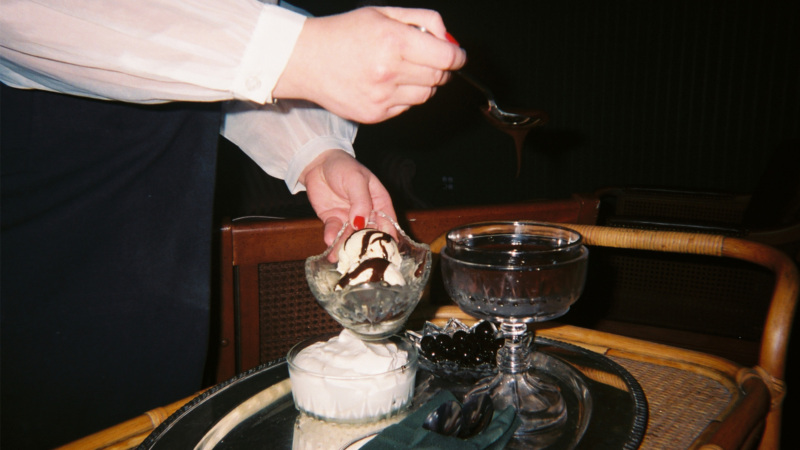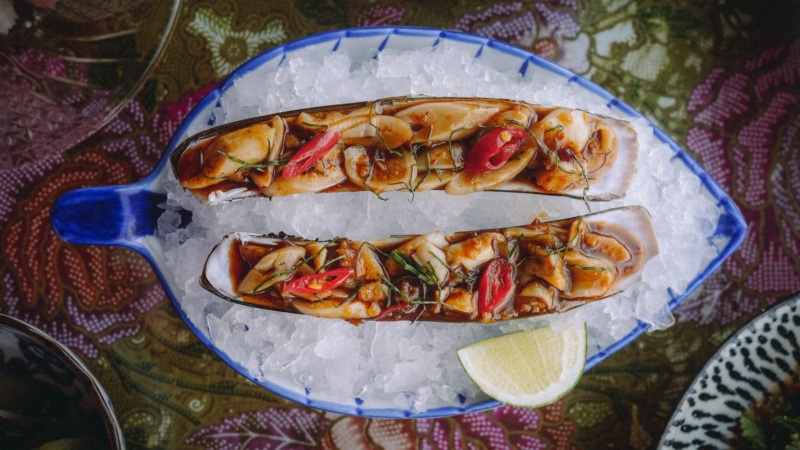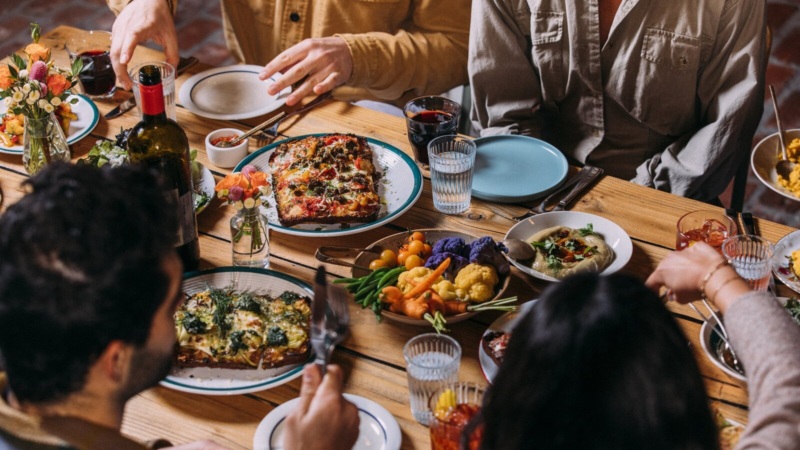
How Bryant Ng Blends Cultures at Cassia, As Seen Through Seven Dishes
Cassia, the wondrous Southeast Asian brasserie that chef Bryant Ng opened in 2015, is one of the most deeply personal restaurants in Los Angeles. Ng and his wife and business partner, Kim Luu-Ng, had previously run The Spice Table, a beloved restaurant in L.A.’s Little Tokyo that they were forced to close in 2013.
At The Spice Table, in a building that had to be demolished for the creation of a new train station, Ng cooked dishes like laksa, kaya toast, beef rendang, satays, and bánh mìs to represent the flavors that he and Luu-Ng grew up eating. Now at Cassia in Santa Monica, which is part of the Rustic Canyon Family of restaurants, Ng and Luu-Ng have a bigger platform to showcase the food they love.
“The food we’re cooking comes from my heritage and Kim’s heritage,” Ng says. “Mine being Singaporean Chinese and Kim’s being Vietnamese.”
Ng’s grandparents and parents owned Chinese American restaurants in Los Angeles, and he remembers helping out in the kitchen as a child. But his path to becoming one of the city’s most accomplished chefs was not linear. He studied molecular, cell, and developmental biology at UCLA before working in biotech.
“I just realized that I didn’t want to do that for the rest of my life,” he says. “I knew I loved cooking.”
After going to culinary school in Paris and working at high-profile restaurants including L.A.’s Campanile and Pizzeria Mozza, New York’s Daniel, and San Francisco’s La Folie, Ng also realized he should be cooking food that represents who he is.
Ng’s menus have been celebrated at both his previous and current restaurants, but it was Cassia that garnered a huge three-star nod from Pete Wells, his first starred New York Times review for a restaurant outside of the New York metropolitan area. That meant a lot to Ng, who earned those stars serving exactly what he wanted, blending together different cultures and merging taste memories with new flavor combinations.
This amalgamation of influences is Cassia at its core. With beloved greatest hits like grilled pig’s tail alongside new crowd-pleasers like minced duck dan dan noodles, Ng’s restaurant hasn’t lost a step since its 2015 opening.
Here’s Cassia, as seen through Ng’s own words and seven of the restaurant’s standout dishes.
- Cosa Buona’s Twists on Italian-American Classics, As Seen Through Five Dishes
- The Resy Guide to Dining Along the Coast in Los Angeles
- A Local’s Guide to Eating Your Way Through Long Beach’s Incredible Cambodian Restaurants
- The Resy Guide to Drinking Natural Wine in L.A. Right Now
- How Hanchic Adds an Edge to Korean Tradition, As Seen Through Five Dishes


1. Steak Frites
“We get a call from Josh Loeb [of Rustic Canyon Family]. He says there’s this space in Santa Monica, but it’s a big space. Because it’s such a large space, I knew Josh wanted to partner up with somebody.
So we came and looked at the space, and I began to think, well, what type of restaurant is this size and is bustling? Immediately, it was like a French brasserie. Something like Balthazar comes to mind. Or L’Express in Montreal is smaller, but it has that energy we were looking for. And in a way, a brasserie makes complete sense. You have this history with the French and Vietnamese. And of course, there’s f—ing colonization, which is horrible and that’s its own history. But out of that came some pretty good food.
We took the brasserie idea and ran with that. What do we call it? It’s French, and there’s definitely some Southeast Asian influences from Singapore and Vietnam. What is it? It’s a Southeast Asian brasserie.
We took dishes that came from different points of view. Steak frites is a very classic French dish. I remember having a version of it at L’Express and I was just like, ‘This is amazing.’ They use hanger steak, and there’s just this way they butchered it, and we actually emulate them now. Just straight up copied the way they butchered it because it’s beautiful.
To meld in those Southeast Asian Vietnamese flavors as well, we use anchovy salt. We also get black peppercorns from Phú Quốc Island in Vietnam. I made a black peppercorn sauce. It became this hybridization of these different cultures.”
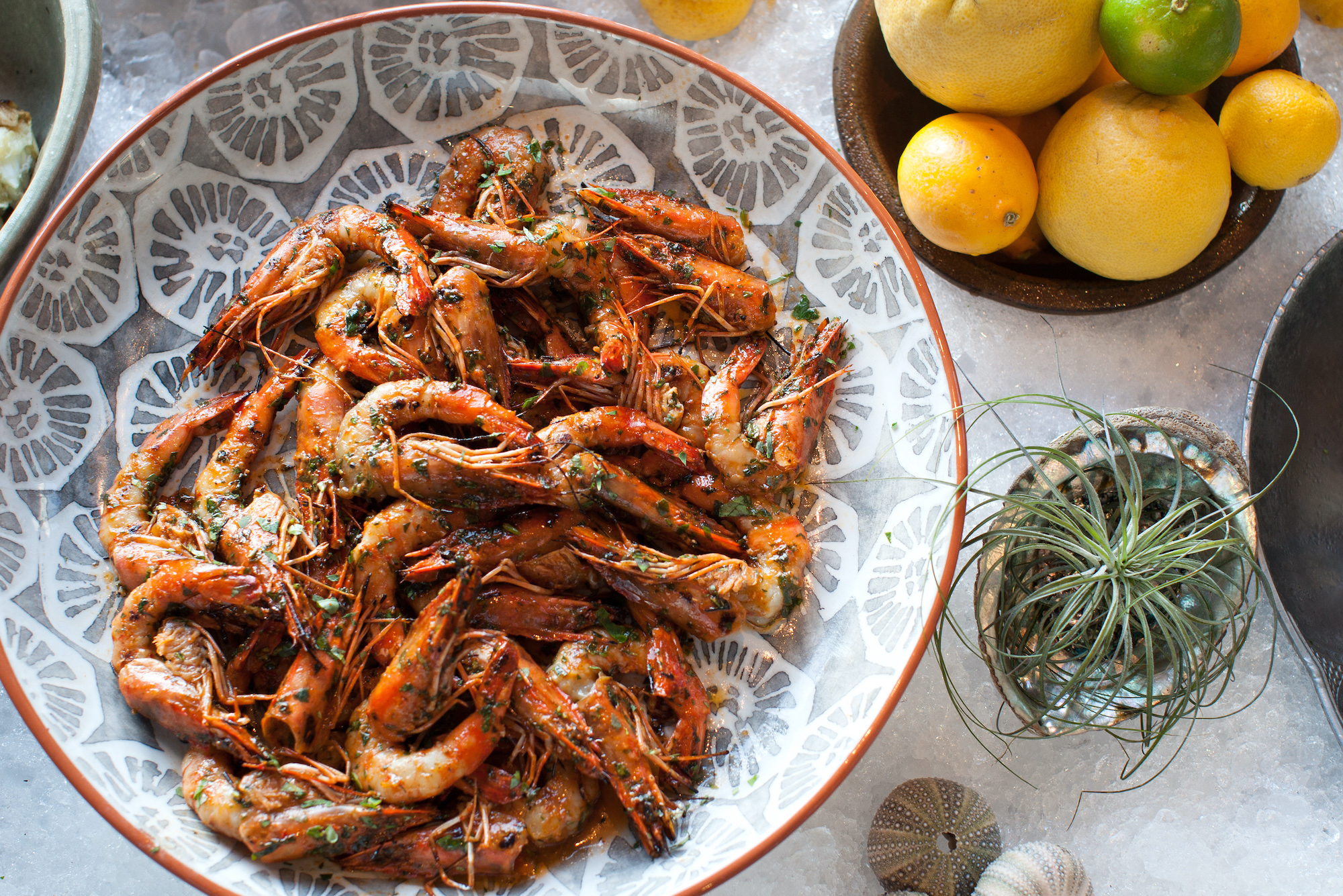

2. Vietnamese Sunbathing Prawns
“We have a chilled seafood section. We very much looked at the seafood platters that you see in a lot of French brasseries and went, well, ‘How do we do our version of that? What does that look like?’
The sunbathing prawns is my version of peel-and-eat shrimp. Only we’ve peeled it for you already. Then instead of just poaching it, we grill it so it gives it that smoky flavor. We caramelize the marinade and then chill it.
This is a recipe I learned from our friend, chef Võ Quốc, in Vietnam. We were visiting Saigon before we opened Cassia, and he cooked us this dish. What’s so funny is I’m pretty sure he threw it in the microwave to cook it. I have no problem with microwaves, but it was pretty impressive that he cooked it in the microwave. It just had so much depth of flavor, and then it had that spiciness to it as well. It looks like someone sunbathing, getting red.
He gave me the recipe. Fresno chiles, garlic, sugar, fish sauce, salt, canola oil, and, to make it authentic, chicken powder. If you’re cooking any Asian food, everyone’s using chicken powder, right? I was like, ‘Damn. That’s why it’s so good.’ That’s the marinade. You blend it all together. For us, we partially peel the prawns. We leave the head on, we leave the tail on. Then we marinate it overnight, and then we grill it.
After we grill it, we let it chill. Prior to serving it, we toss it with olive oil and some chopped laksa leaves. Then we serve it with some lime on the side. Also, we have a hot sauce that we make, which is pureed chiles and garlic, some sugar, sriracha, and some vinegar. And we let that sit.”


3. Clay Oven Bread With Koda Farms Chickpea Curry
“I’m a bread person. Oddly enough, being Asian, I should be a noodle or rice person, right? It’s weird. I’m a bread person. When I was really young, I was in Hong Kong. We’re eating at a restaurant called Plume, and Gray Kunz was the chef. I didn’t know this at the time. I did some research later.
What they served was naan, and they served it with butter and pâté. It’s still one of these taste memories that I just freak out over. I said, ‘OK, look, we have the opportunity in this big space that’s 6,500 square feet. I can put in a tandoor oven, and we can make our own version of naan.’ So that’s what we did. It came from that taste memory. It’s Indian, but I actually had it at a French restaurant in Hong Kong, you know what I mean? This is all jumbled together at this point.
That’s where the clay oven bread section came from. The bread is a soft dough that we use. It ferments overnight. There’s some yogurt in there and butter, some classic Indian flavors. We add a little bit of whole wheat in there as well to give it some nuttiness. Of course, we cook it in the tandoor. To me, it definitely resembles naan in so many different ways, and not just in the way that it looks. Textually, what I love about naan in general is that you get the crispy bits, you get the chewy, softer, pillowy bits, and then you get that char on it as well.
The chickpea curry, interestingly enough, is actually the recipe I used at Spice Table for our chicken curry dish. But I intentionally wanted to make it vegetarian so that it had a broader appeal. I replaced the chicken with chickpeas. We don’t use fish sauce in it, but we use shio koji to give it another depth of flavor where the fish sauce would normally be. It started from a chicken curry recipe that was Singaporean, and I flipped it to become a chickpea curry.”
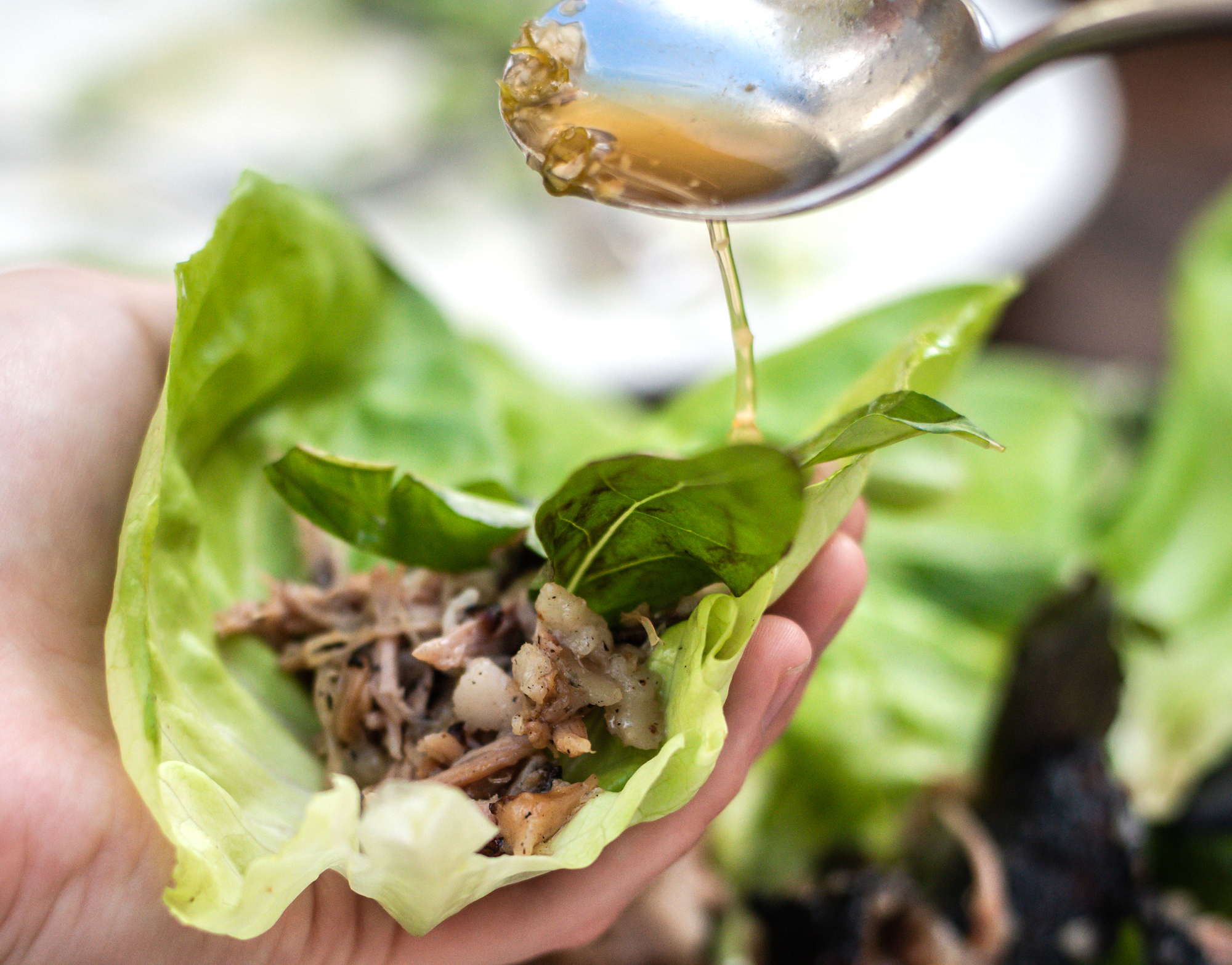

4. Grilled Pig’s Tail
“For me, it’s a point of pride that we’re here in Santa Monica and we can sell a ton of pig’s tails.
This dish is from Spice Table, and we just loved it. Its inspiration came from nem nướng, the Vietnamese sausage. That flavor profile and how you wrap it with herbs and lettuce was really where it started. Then looking at the past when I’ve cooked pig’s tail, I’ve just really loved the ratio: There’s lean meat, there’s fat, and there’s skin. It has all of that in this wonderful beautiful ratio. And when you wrap it in something that’s lighter, like herbs and lettuce, and dip it in fish sauce, it really balances well.
We braise it with ginger, garlic, fish sauce. Super simple braise. There’s some palm sugar in there as well. We braise it for three hours, so it falls apart. Then we grill it to give it that char and some smokiness and then just serve it as is with the lettuce, herbs, and the prepared fish sauce. This is Kim’s mom’s recipe. It’s fish sauce, there’s garlic in there, some chiles, lime juice, sugar.
It’s actually an all-purpose prepared fish sauce that we also use for our cauliflower dish.
I just absolutely love the pig’s tail because it has that balance. For people that have never had pig’s tail before, it’s a nice introduction. It’s just so flavorful as well because it just absorbs all of that flavor when you braise it.
We brought it over from Spice Table because it was one of those dishes that I felt represents what it is that we do. Not only that, it’s like, during the course of someone’s career as a chef, you definitely have dishes where you’re like, ‘Damn, that’s really really good.’ There’s other dishes where you’re like, ‘Oh, that’s OK.’ But sometimes you hit something. And you’re lucky if you hit a bunch of these, right? The pig’s tail was one of those things where you think about it, you execute it, and then you sit to eat it, and it’s like, ‘Wow, it really just worked in such a beautiful way.’”


5. Laksa
We had laksa at Spice Table too. It’s just one of those dishes that, number one, is pretty hard to find in Los Angeles. I felt that it represents us and what we do and Singapore. Plus to me, it’s just a really soulful dish. Really great flavors. It has a spiciness to it. We like to amp it up a little bit. Just really great balance, as well. It’s one of those dishes where I believe, if you’ve traveled to Southeast Asia, a lot of the flavor profiles within that dish really hit those notes that remind you of Southeast Asia. Plus, it’s a little messy in that way, too, which is nice, right?
This laksa is specifically from an area in Singapore called Katong. It’s Katong laksa. There’s different laksa throughout the world. This one tends to be a bit more on the creamier side because it is coconut milk-heavy. But it still has a huge punch of shrimp. We basically use every form of shrimp imaginable. What we have is fermented shrimp paste, dried shrimp, and actual shrimp.
One thing I wanted to always be cautious of when we opened here in Santa Monica was doing something where someone would say, ‘Oh, they’re dumbing it down for white people.’ If I have to dumb down a dish, I’m just not even going to serve it. The idea is, if we’re going to do it, we’re going to do it and do it right, and make sure that the spice level is amped up to the way that we think is appropriate.
That may be a little slightly above what the average person is OK with, but that’s the whole point. We want it to be genuine in that way. There’s a lot of dried chiles in there. We get pretty potent chiles from Southeast Asia. We grind those into a chile powder and use it as the base.”


6. Vietnamese-Cajun Crab, Crawfish, and Corn Dip
“It comes from that hybridization of Vietnamese food and Cajun food. If you think about a place like Boiling Crab, you have all those flavor profiles. But then also, we put fish sauce in there. And there’s garlic and lemongrass in there and makrut lime leaf as well, to really give it that Asian push.
This started off as a crawfish dish. We’d take the crawfish, cook it in all of these Cajun-Vietnamese spices, and then put it on top of cold noodles. From there, John Stenbakken, who was our chef de cuisine, and our kitchen manager, Carlos Quintero, were messing around for staff meal and put crab in it. It tasted so good with crab.
So fast forward to now. I want to put another chilled seafood dish on the menu. We already know the flavor profiles work with the crab and crawfish. So we mixed it all together, cooked it together and that became the base. We bind it with a little bit of mayo, so that it just holds together, and a little bit of lime juice. Then on top of it, there’s this salted egg yolk crumble. I take salted egg yolks and cook them in butter with some Thai chilies, then crushed Ritz crackers and mix it in.
We serve it with shrimp chips. You have the crawfish, you have the crab, you have the salted egg, you have the crumble. Squeeze on a little bit of lime, and then you put it on top of a shrimp chip. It just has all these flavors. It’s eating chips, but then it’s packed with a lot of crawfish and crab too.”


7. Spicy Minced Duck Dan Dan Noodles
We’ve had so many different versions of dan dan noodles throughout our lives, in different countries, and even here. This is a shout-out to Dai Ho in the San Gabriel Valley. Kim and I go there all the time. Honestly, they have the best beef noodle soup. They also have a version of dan dan noodles, but there’s an off-menu way of ordering it where you can get minced meat on top of it and make it spicy. I just remember eating that and being inspired by that.
Usually. you’ll find ground pork in dan dan noodles. I wanted to see what it was like to use duck. We ended up using ground duck, which is nice because it gives it this gamey flavor. It actually makes a lot of sense. The duck itself made it pretty unique.
Usually when you make dan dan noodles, there’s some sauce that’s either sesame-based or peanut butter-based or something like that. We’re using sesame. Instead of using traditional Chinese sesame paste, which tends to be a bit more bitter, a little more aggressive than, for instance, tahini, I looked at tahini. Wow, it’s a really similar flavor profile, maybe a bit more mellowed out. But more importantly, when you’re eating dan dan noodles in general, you’ve got to eat it within the first five or 10 minutes. Otherwise, the whole thing just seizes up, right? It just congeals together. That’s really because of the sesame paste or peanut butter, because at room temperature, those are solids. Whereas the tahini that we use is more of a softer, liquid-type paste. It’s not really a solid.
I realized that using tahini will allow the dish to have a lot better longevity. You can sit there longer and still have the flavor profile, and it doesn’t seize up on you. From a texture point of view, it just made so much more sense.
We use two different types of Sichuan peppercorns for this. We use the red and the green. I actually finish with the green on top because it has more of a floral component. It’s really funny. If you’re not used to eating Sichuan peppercorns, and there are plenty of people who aren’t, maybe you smell the green one for the first time and think it’s a bit too floral. We even had a table who were like, ‘Oh, it smells like soap.’ We’re like, ‘That’s just the Sichuan peppercorns.’
OK, it’s not for them. That’s fine. But you know what? That’s part of what we do. What we’re supposed to do is educate palates. Even though they sent it back, now they know what green Sichuan peppercorns smell like.”
Andy Wang has written regularly about restaurants for publications including Food & Wine, Los Angeles magazine, and Robb Report. He was previously the real estate and travel editor at the New York Post. Follow him on Twitter and Instagram. Follow Resy, too.


